尼泊尔立法机构中公民平等代表权问题:言论与现实
IF 1
Q3 POLITICAL SCIENCE
引用次数: 3
摘要
摘要在尼泊尔这样的多民族社会中,立法机构在多大程度上代表了所有社会群体的观点是一个核心问题。1959年至2013年对所有代表的描述性和推断性统计分析结果表明,尼泊尔立法机构中种姓/族裔群体的代表性长期不平等。历史上,少数民族在所有政治制度中都形成了“奶油层”。尽管妇女和一些被排斥的身份在后期获得了大量席位,但许多群体,特别是历史上被边缘化的群体,进展太慢。代表性模式在很大程度上与政治制度的设计有关,如选举制度和种族配额,以及与贫困、财富、成人识字率和人类发展相关的群体的社会经济地位。这些发现表明,平等代表权的机会不仅体现在群体努力的价值上,还体现在其通过权力和资源影响政治进程的能力上。因此,改革政治机构,特别是选举制度,改善妇女的社会经济地位和被排斥的身份,所有这些都需要强有力的政治意愿和承诺,可以缩小政治代表性的不平等。本文章由计算机程序翻译,如有差异,请以英文原文为准。
The question of equal representation of citizens in the legislature of Nepal: rhetoric and reality
ABSTRACT To what extent the legislature represents the views of all social groups is a central question in multiethnic societies like Nepal. The results from descriptive and inferential statistical analysis of all representatives from 1959 to 2013 show the existence of a prolonged unequal representation of caste/ethnic groups in the legislature of Nepal. A few subgroups of peoples have historically created a ‘creamy layer’ throughout all political systems. Although women and some excluded identities have gained substantial seats in the later period, progress for many groups, particularly historically marginalized ones, has been far too slow. The representation patterns are largely associated with a design of political institutions, such as electoral system and ethnic quotas, as well as the socioeconomic status of a group linked to poverty, wealth, adult literacy, and human development. These findings suggest that the chances of equal representation appear not just to the worth of group effort rather than its ability to influence the political process through power and resources. Thus, reforming political institutions, particularly the electoral systems, and improving the socioeconomic status of women and excluded identities, all of which demand strong political will and commitment, may narrow down inequality in political representation.
求助全文
通过发布文献求助,成功后即可免费获取论文全文。
去求助
来源期刊

Asian Journal of Political Science
POLITICAL SCIENCE-
CiteScore
2.00
自引率
0.00%
发文量
11
期刊介绍:
Asian Journal of Political Science ( AJPS) is an international refereed journal affiliated to the Graduate School of Public Administration, Seoul National University. Published since 1993, AJPS is a leading journal on Asian politics and governance. It publishes high-quality original articles in major areas of political science, including comparative politics, political thought, international relations, public policy, and public administration, with specific reference to Asian regions and countries. AJPS aims to address some of the most contemporary political and administrative issues in Asia (especially in East, South, and Southeast Asia) at the local, national, and global levels. The journal can be of great value to academic experts, researchers, and students in the above areas of political science as well as to practical policy makers, state institutions, and international agencies.
 求助内容:
求助内容: 应助结果提醒方式:
应助结果提醒方式:


